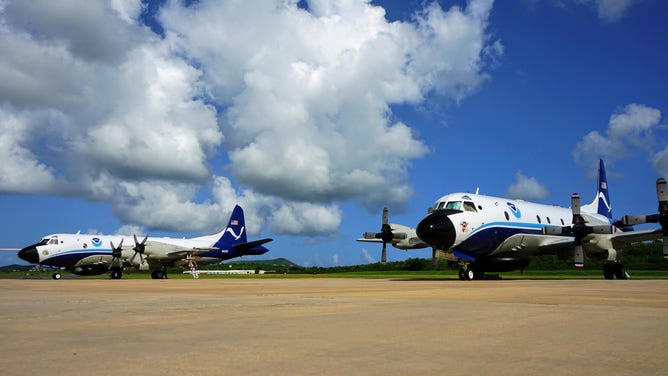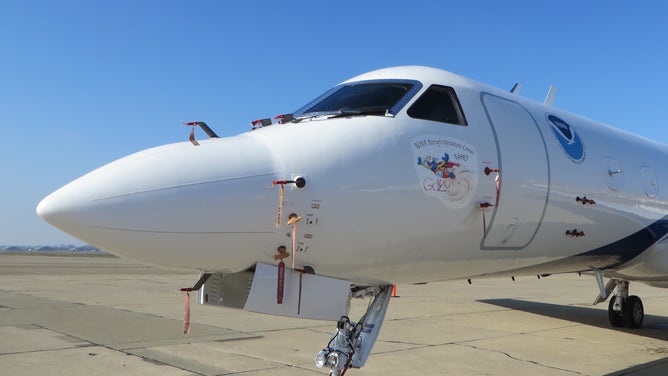How ‘Kermit’, ‘Miss Piggy’ and ‘Gonzo’ hunt down hurricanes
To study some of Mother Nature’s most powerful creations, scientists use aircraft emblazoned with some of Jim Henson’s most colorful creations
How 'Kermit', 'Miss Piggy' and 'Gonzo' hunt down hurricanes
The three Muppets are namesakes for NOAA aircraft used to study and forecast tropical cyclones. (Images courtesy of The Jim Henson Company and NOAA)
It’s not easy being green — and neither is forecasting hurricanes.
But meteorologists can get the job done, thanks to "Kermit", "Miss Piggy" and "Gonzo".
Kermit, Miss Piggy and Gonzo are three National Oceanic and Atmospheric Association aircraft known as hurricane hunters, meteorological stations that fly toward hurricanes to gather critical weather data.
Muppets on a mission
"Kermit" and "Miss Piggy" are WP-3D ("P-3") Orion aircraft, which fly into hurricanes at an altitude of about 10,000 feet. The aircraft are large and tough and can fly through the eyewall of a tropical cyclone, the most intense part of the storm.
Gonzo is a Gulfstream-IV ("G-IV") aircraft, an agile jet that soars over hurricanes at an altitude of up to 45,000 feet. As hurricanes can reach heights of about 60,000 feet, the jet flies high as it observes the storms, their surrounding environment and their movements.
Flying toward hurricanes to study them
Commander Rebecca Waddington, who pilots the Gulfstream-IV aircraft ("Gonzo"), explains how devices called "dropsondes" are dropped into hurricanes to gather data about the storms.
As they play such a critical role in hurricane research and forecasting, the three hurricane hunters do so with a bit of flair.
Painted right below the pilot-seat window of each aircraft are the aircraft's namesake Muppets.
LEARN HOW ONE WOMAN BECAME A PILOT ON ‘GONZO’
But how did three of Jim Henson’s most colorful creations become associated with studying some of Mother Nature’s most powerful creations?
First up, Miss Piggy

A NOAA Lockheed WP-3D Orion aircraft with a Miss Piggy logo near the nose of the aircraft from Sept. 2019.
(Jonathan Shannon / NOAA)
The story begins over thirty years ago with the P-3 aircraft and an imaginative maintenance crew at NOAA.
According to NOAA Director of Maintenance Greg Bast, who was the P-3 crew chief with NOAA’s Aircraft Operations Center in the early 1990s, the aircraft’s mechanic at the time was not too keen on its cosmetic appearance. The P-3 was called the "pig" around the maintenance department due to its looks.
Bast and P-3 flight engineer Steve Kirkpatrick shared this sentiment and were even determined to change the aircraft’s appearance over the following year. In the meantime, they decided to call the P-3 Miss Piggy as the Muppet character is always particular about her appearance.
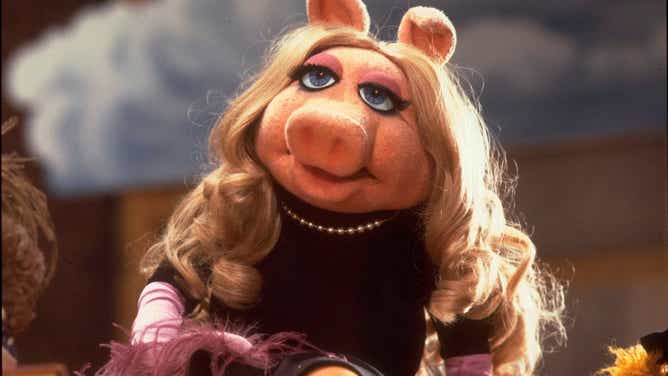
Miss Piggy on the set of The Muppet Show at Elstree Studios, Hertfordshire, circa 1979.
(TV Times / Getty Images)
The name Miss Piggy became popular around the Aircraft Operations Center, and the P-3 aircraft that bore the Muppet’s name became "one of the nicest looking aircraft" they had, according to Bast.
Bast, who referred to himself as "a frustrated artist at heart," even drew a logo featuring Miss Piggy. He and Kirkpatrick then used the logo inside the P-3 and throughout their workspaces.
Working with Jim Henson Production
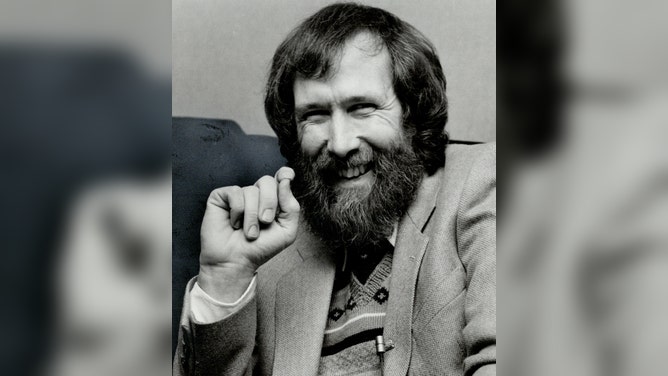
FILE - Jim Henson was thrilled about the idea of creating a "Miss Piggy" logo for NOAA, according to Bast.
(Colin McConnell / Toronto Star / Getty Images)
Little did they know that "Miss Piggy" would soon gain official status. At the suggestion of one of their pilots, CDR Ron Phillipsborn (now retired), the team reached out to Henson Productions about a possible collaboration.
Jim Henson was thrilled about the idea, according to Bast. Thus began a cascade of events that involved creating art for the P-3 and brainstorming what its design would look like.
Working with Michael Frith, Director of Muppet Productions at the time, Bast helped develop a Miss Piggy design inspired by his logo and World War II-era aircraft nose art.
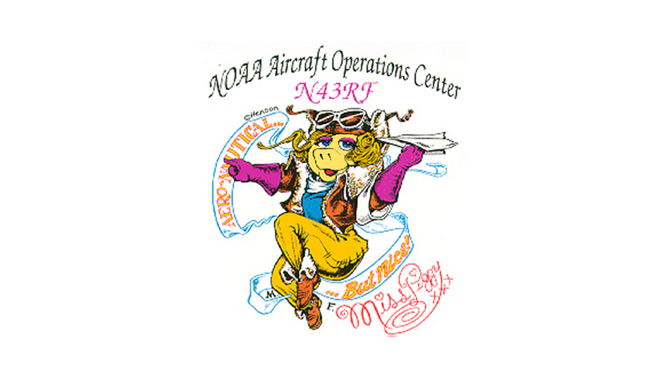
The final "Miss Piggy" logo, designed for the NOAA hurricane hunter WP-3D Orion aircraft.
(The Jim Henson Company / NOAA)
But while designing one Muppet logo for the P-3, a second Muppet logo came to be. Knowing that NOAA had a second P-3, Frith came up with the idea of featuring Kermit on the aircraft, given that both the two aircraft and Kermit and Miss Piggy are close pairs.
The Kermit and Miss Piggy logos were then placed on the aircraft and, with Frith and other members of Henson Productions, later formally unveiled at NOAA’s facility in Miami.
A triumvirate of Muppets
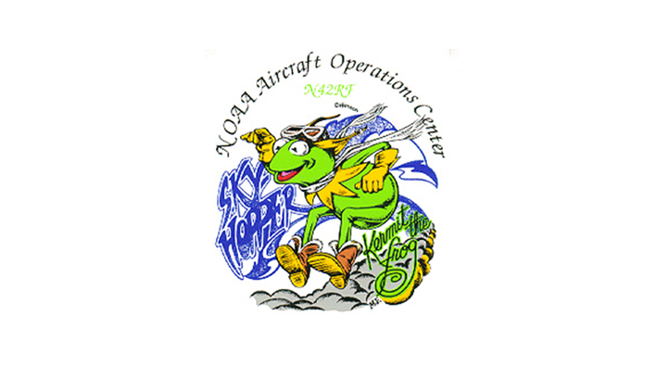
The final "Kermit" logo, designed for the NOAA hurricane hunter WP-3D Orion aircraft.
(The Jim Henson Company / NOAA)
The third and last hurricane hunter, the G-IV, would soon get its time in the Henson spotlight.
In 1996, Bast and his team worked with Henson Productions to create a logo for the G-IV. Taking inspiration from the aircraft’s non-standard nose radome, the Muppet chosen for the G-IV was the long-nosed Gonzo.
In the decades since, the aircraft have worn the playful logos and have affectionately come to be called by their Muppet namesakes.

The final "Gonzo" logo, designed for the NOAA hurricane hunter Gulfstream-IV aircraft.
(The Jim Henson Company / NOAA)
"Although the birth of these logos was somewhat ‘tongue in cheek,’ the Aircraft Operations Center has used the logos to pique the interest of children of all ages, around the country and the world, in atmospheric research," Bast said.
According to Bast, his team hands out small replica logo stickers to children and adults who visit their facility and aircraft, adding that the logos always draw attention to the aircraft everywhere they go.
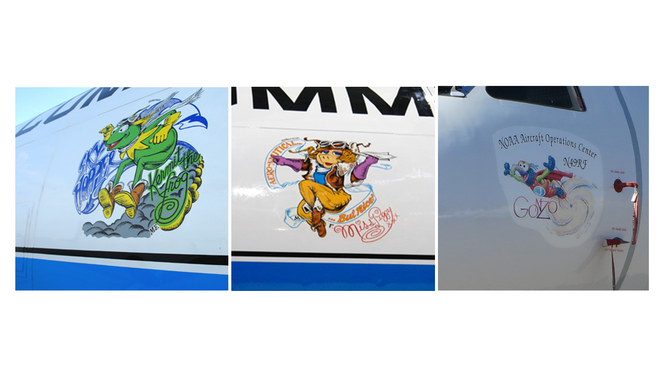
The Kermit, Miss Piggy and Gonzo logos displayed on two P-3 and one G-IV aircraft, respectively.
(The Jim Henson Company / NOAA)
"Henson Productions has been very kind to us, and we are very proud to have these logos on the side of our aircraft," Bast said.
"The logos have put some fun into what we do and enhanced our visibility to the public," he added. "The nicknames for the aircraft have become such a big part of our tradition around the Aircraft Operations Center that the aircraft are seldom referred to by their registration numbers anymore."

